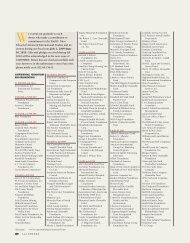Download Current Issue - SAIS
Download Current Issue - SAIS
Download Current Issue - SAIS
You also want an ePaper? Increase the reach of your titles
YUMPU automatically turns print PDFs into web optimized ePapers that Google loves.
The New Oil?<br />
By Mariano Turzi<br />
In the coming years, access to edible<br />
commodities will become a key strategic<br />
source of power, bringing back to the<br />
forefront an old fault line in international<br />
relations: food geopolitics.<br />
The strategic relevance of agricultural<br />
products has been undervalued<br />
relative to other natural resources such<br />
as gold, silver and oil. Since the mid-<br />
20th century, an age of abundance and<br />
economic development, oil has been<br />
regarded as the most critical commodity.<br />
But agricultural commodities are much<br />
more vital goods: One can substitute<br />
driving for public transportation but<br />
cannot help eating and drinking on a<br />
daily basis. If energy scarcity can disrupt<br />
the normal functioning of a society, the<br />
absence of food and water can cause its<br />
sudden breakdown.<br />
As the geopolitical balance between<br />
the emerging and the developed world<br />
shifts, several trends will combine to<br />
intensify competition for food products.<br />
Decision-makers will face new<br />
national security dilemmas and foreign<br />
policy challenges. Some will come from<br />
increased demand and others from the<br />
nature of the supply system.<br />
World demand for agricultural commodities<br />
is driven by three Fs: food, feed<br />
and fuel.<br />
The first leg, food, is the result of an<br />
impressive background demographic<br />
dynamic: The global population, which<br />
grows by around 80 million people per<br />
year, was expected to surpass the 7 billion<br />
mark by late 2011 and to reach<br />
9 billion by the end of the century.<br />
Renowned agronomist Norman Borlaug<br />
estimated in 2009 that over the next 50<br />
years, the world will have to produce<br />
more food than it has in the past 10,000<br />
years. This means a structural upward<br />
shift in food demand.<br />
The second component, feed,<br />
answers to the rise of the emerging<br />
world, with particular focus on Asia.<br />
When living standards rise, so does<br />
demand for meat and dairy products.<br />
As people from Brazil, China and India<br />
abandon poverty and move into the<br />
Year of<br />
Agriculture<br />
at<strong>SAIS</strong><br />
burgeoning middle class, they diversify<br />
their diets to include more vegetable<br />
oils, meat and dairy products. There are<br />
not only more people, but also more<br />
people eating pork, chicken and beef.<br />
The third element is fuel. Expectations<br />
of oil price hikes and supply<br />
shortages have triggered a growing<br />
demand for energy from the biofuels<br />
industry. Supported by policy mandates,<br />
countries are seeking to diversify<br />
their energy sources by incorporating<br />
renewables. When the international<br />
price of corn soared in 2007, Mexico<br />
underwent a period of social unrest and<br />
political instability due to the “tortilla<br />
wars.” When corn demand from U.S.<br />
ethanol plants soared in 2007, prices<br />
spiked across the border. In the “tortilla<br />
wars,” tens of thousands of protesters<br />
took to the streets of Mexico City and<br />
demanded a solution to the 50 percent<br />
increase in the price of corn tortillas, a<br />
staple of Mexican diet and culture.<br />
On the supply side, climate change is<br />
generating increased temperature volatility<br />
and alteration of precipitation patterns.<br />
In 2010, for example, a drought<br />
and heat wave decimated the Russian<br />
wheat harvest, leading to a rise in the<br />
price of flour and bread worldwide. Second,<br />
there are severe price distortions<br />
due to global investors’ hunting for<br />
safe hedges to diversify their portfolios<br />
in times of financial turmoil, turning<br />
commodities into an asset class. New<br />
investment products—food derivatives<br />
and indexed commodities—open speculative<br />
opportunities that put upward<br />
pressure on prices. Third, as urbanization<br />
grows—in 2010 more than half the<br />
world’s population became urban—land<br />
available for cultivation decreases.<br />
Finally, water mismanagement and<br />
overproduction are leading to increasing<br />
desertification, destroying previously<br />
arable land. Although not immune to<br />
criticism, biotechnology developments<br />
have the potential to counter these<br />
supply-reducing trends.<br />
Desperate for Land<br />
The nature and composition of world<br />
agricultural demand and supply are<br />
fast becoming important dimensions<br />
of international relations, opening up a<br />
2011–2012 55



